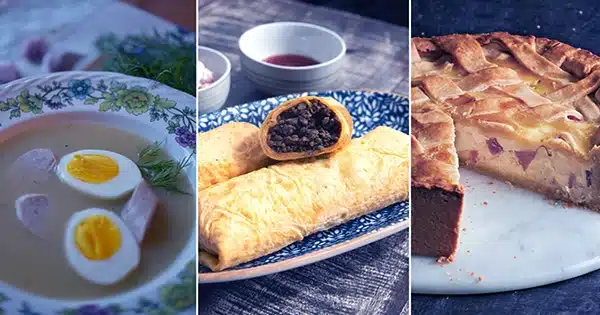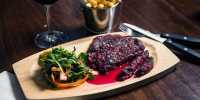Easter is a time for joy, and one of the most important aspects of this holiday is the delicious cuisine that is prepared and given at gatherings. While we may consume roast ham and chocolate eggs in the United States, many nations have their own traditional foods and methods of honoring Easter. Some nations, such as Greece, even observe Easter on a separate day.
Easter celebrations vary by culture and are often rooted in the country’s history and faith. Each meal has its own tale to share, from the UK’s hot cross buns to Eastern Europe’s butter lamb, Romania’s cheesecake bread to Georgia’s hearty lamb stew.
It’s interesting to learn about the origins of these customs and the differences and parallels they share. Whatever way you choose to celebrate Easter, we’ve rounded up some Easter food traditions from around the world to give you a little insight into how others mark this special holiday.
USA: Roast ham
The typical Easter meal in the United States is roast ham, which is often glazed with honey, maple syrup, or brown sugar and sometimes sprinkled with cloves. Many people choose to serve their ham with grilled pineapple slices for a delicious sweet and savory take on this Easter tradition.
However, why do we consume pork on Easter? Though the lamb was traditionally the meat of choice for Easter festivities, the shift to ham has nothing to do with faith; we consume it because it is in season and less expensive than lamb. However, many nations around the globe still enjoy roast lamb for Easter supper.
Farmers discovered that ham could be cured to keep it fresh throughout the long winter months, ensuring it was ready to consume by the time Easter rolled around in the spring. However, not everyone in the United States eats a roast ham on Easter Sunday, with many families choosing roast beef or poultry instead.
Poland: Zurek
Zurek is a sour rye soup that is typically offered at Easter in Poland. It’s typically served with a boiled egg and made with spicy white Polish sausage, smoked meat, potatoes, seasonings, sour rye starter, carrots, and basil. It’s frequently presented in a hollowed-out edible bread wrap.
Due to the addition of the sour rye starter, which gives the soup its trademark sour taste, the term “Zurek” originates from the ancient German word “Sur” meaning “sour.” There are several genesis tales for this broth, but the Mean Innkeeper is the most intriguing.
According to legend, a penny-pinching innkeeper in a Polish hamlet frequently offered foul cuisine prepared with subpar materials at his bar. People started avoiding hamlet completely as news got out. To punish him, the locals sent a haughty local clad in finery and carrying a bag of money to the tavern to dine.
The man wagered the host that if he prepared the most disgusting soup he could imagine and could consume it, the landlord would get to keep the money. Naturally, the landlord seized the chance and made broth out of rotten veggies, water, rye, stale meat, and whatever else he could find.
Surprisingly, the guest completed the cup of soup and requested another, with residents attracted to the bar by the scent of the soup. The “mean innkeeper” gave away the formula for the broth as well as his bar and never returned to the town.
UK: Hot cross buns
In the United Kingdom, traditional hot cross buns were made with succulent raisins and consumed on Good Friday. Various varieties, including those studded with chocolate, salted caramel, or filled with fruit, are now available all year.
Hot cross buns get their name from the cross emblazoned on top, which represents Christ’s execution. It was also said that hanging hot cross buns in your kitchen would ward off evil entities and avoid cooking fires.
Hot cross buns are reputed to have been created in the 12th century by a monk as a celebratory meal for the impending Easter holiday. In a text from the 16th century, they are first referenced in writing as follows: “Good Friday comes this month, the old woman runs, with one or two a penny hot cross buns.”
Others assert that the pastries’ origins are ancient. Similar cakes were made in Ancient Greece and Rome and decorated with crosses in Ancient Egypt to honor the Gods.
We may never know the true roots of the hot cross bun, but the truth remains that they’re a delectable delicacy, especially divided, toasted, and slathered with salted butter. You could even present these buns to pals as a gift, as it is said to improve friendships.
Romania: Pasca
Pasca is a customary sweet Romanian Easter bread that is comparable to Pannetone in Italy. The bread is filled with a sweetened cheesecake combination prepared with branza de vaci (cow’s cheese) with rum and raisins in Romania, but blended cottage cheese can be substituted. Over Easter, Ukrainians consume bread with the same moniker but without the stuffing.
Pasca was typically the first meal eaten for Easter breakfast, signaling the end of Lent’s 40-day fast. It is now made and consumed during Romanian Easter festivities.
There are many dated customs and beliefs connected with making the bread, and the golden color of Pasca symbolizes the sun, the giver of life. It’s said that the family will experience a mortality that year if the bread splits when you take it out of the oven or if it doesn’t rise.A less morbid belief holds that no one, not even those who prepared the bread, should sample it before it is consecrated at the Easter Sunday church service.
Finland: Mämmi
Mämmi is a typical Finnish Easter dessert consumed in Southern Finland. It has a doughy, dark rye flavor that takes some getting used to because it’s made with rye barley, rye flour, sugar, orange peel, and raisins. It’s a divisive meal, with people either adoring it or despising it. Molasses is also used in some dishes.
Mämmi is quick to make and bake, but it needs to chill in the freezer for three to four days. As a result, many Finns nowadays purchase their Mämmi already made. Mämmi is typically served with cream and sugar or milk, whether made from scratch or purchased from a neighborhood shop.
It is believed that the origins of this cuisine date back to the 13th century. Since documents from the year 1700 mention a dish with a similar-looking name, it is possible that Finns have been savoring this Easter treat for a while.
Greece: Tsoureki
Tsoureki is a sweet pastry similar to brioche that is typically made on Holy Thursday, the Thursday before Orthodox Easter. It’s great for morning and dipped in coffee, and it also makes great french toast.
Throughout the year, different flavors of Tsoureki are sold in shops in Greece. The authentic Easter variation, on the other hand, is prepared with butter, eggs, milk, flour, sugar, yeast, and salt. Tsoureki’s distinct flavor is imparted by two special ingredients: mahlepi, a spice derived from powdered cherry seeds that lends an almond flavor, and mastic (pine resin gum), which gives the bread bitter, refreshing piney flavors.
Tsoureki is believed to have originated in the Byzantine periods, when Easter breads identical to it was made. Its three-stranded plait is said to ward off bad entities and symbolize Christ’s return. To represent the blood of Jesus, a crimson egg is frequently placed on top of the bread at Easter.
Spain: Torrijas
Torrijas is a Spanish sweet treat comparable to french toast that is consumed throughout the nation during Holy Week. To use up stale bread, soak the pieces overnight in milk (or wine, honey, or syrup), then roll in egg, fry, and sprinkle with cinnamon sugar.
Torrijas, one of Europe’s earliest desserts, became famous during Lent in the Middle Ages. The delectable treat is consumed with wine and symbolizes Christ’s body and blood.
Torrijas are typically offered during Easter, but they are now frequently available on normal menus throughout Spain, so you don’t have to wait until Lent to eat them. Torrijas are on the men del da, a typical worker’s menu that was once mandated to be provided at all restaurants in Spain, because they are such a cheap and widely available dish.
Russia: Pashka
Pashka is a cheesecake-like dessert eaten on Easter Sunday in Russia, derived from the Russian term for “Easter.” Though typically prepared with tvorog (cheese curds) blended with butter, sugar, eggs, nuts, and dried fruit, cottage cheese, and cream cheese can be replaced. Some versions include candied citrus, cinnamon, nutmeg, or vanilla extract.
Pashka is a Romanian delicacy identical to Pasca but without sweet bread. This treat, however, is typically spread on Kulich, a sweet panettone-like bread that can also be found in Russian Easter meal settings.
This dessert is usually made in a pyramid-shaped mold to represent the tomb of Christ, with the Russian letters X and B imprinted on the inside of the mold, meaning “Christ is risen!” Traditionally, Pashka is taken to church along with Kulich in an Easter basket, to be blessed before the family sits down to enjoy it.
Jamaica: Eskovitch
Every Easter, Jamaicans prepare Eskovitch, a classic seafood dish. The moniker is comparable to a Spanish meal, Escabeche, but the Jamaican variation includes lime juice, Scotch Bonnet chili heat, and fried bell peppers, carrots, and onions.
The highlight of the meal is the fish, which is marinated in a spicy sauce before being cooked until crispy and topped with veggies. Red snapper is the most frequently used seafood in Eskovitch, but almost any fish will do.
Because it was thought to be bad luck to start a fire before noon on Good Friday, Eskovitch is customarily made on Holy Thursday. Preparing the dish in advance limits the amount of time spent in the kitchen on a holy day.
Typically, bammy, a traditional Jamaican flatbread prepared with manioc (cassava) or rice, is paired with this delicious, spicy fried fish meal. But because Scotch Bonnet chilis are used, the dish is certainly not for those who don’t like spicy cuisine!
Cyprus: Souvla
Souvla is the primary dish traditionally offered on Greek Easter Sunday, a complete day of family feasting. This marinated meat skewer is typically made with lamb, but it can also be made with pig or poultry. The flesh is seasoned simply with salt, pepper, and thyme.
Souvla is traditionally prepared slowly over a spit or on a heated barbecue, with the males of the family watching the preparation while the women prepare side foods. Lemon potatoes and a Horiatiki salad with feta cheese, cucumber, tomatoes, olives, and shallot are common side items.
Souvla and souvlaki are frequently confused, but they are very distinct foods. Souvlaki is a famous street dish prepared with smaller chunks of grilled meat served in pitta bread with onion, parsley, tomato, and sauce, as opposed to souvla, which is a chunky slow-cooked meat skewer usually served as the main course at family parties.
USA and UK: Carrots
Is there anything more delectable than grilled and seasoned carrots? These vibrantly colored vegetables, simply broiled with a sugar (or maple syrup) sauce, make the ideal side dish for your Easter roast ham or roast lamb.
But why are carrots eaten at Easter? Children put carrots out for the Easter Bunny, the legendary entity that bestows chocolate eggs on Easter Sunday. Though there is no clear history of the Easter Bunny, it is believed to have originated with the arrival of German immigrants to the United States in the 18th century. These newcomers carried with them the legend of the “Osterhase,” or egg-laying rabbit. Children would build homes for this enigmatic bunny, which evolved into Easter baskets as the custom caught on across the nation.
It’s not necessary to limit carrots to the role of a side item. Why not bake a carrot cake with cream cheese icing and make it the centerpiece of your Easter spread?















